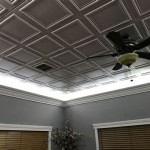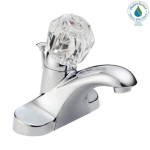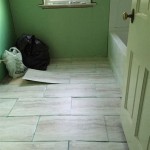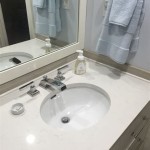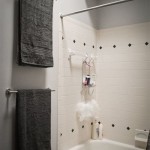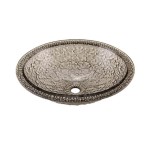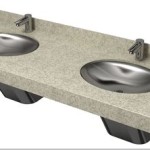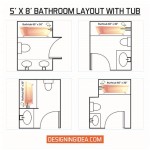Bathroom Floor Tile Design Ideas For Small Bathrooms
Designing a small bathroom presents unique challenges, especially when considering flooring. The choice of tile significantly impacts the perceived size, ambiance, and functionality of the space. Selecting appropriate tile designs can transform a cramped bathroom into a stylish and comfortable retreat. This article explores various bathroom floor tile design ideas tailored for small bathrooms, focusing on factors such as color, size, pattern, material, and layout to maximize the space's potential.
Understanding the Importance of Tile Selection in Small Bathrooms
In a small bathroom, every design element plays a crucial role. The floor tile is no exception. Its visual impact is significant, influencing how the entire bathroom is perceived. Poor tile choices can make the space feel smaller, darker, and more cramped than it actually is. Conversely, strategic tile selection can create an illusion of spaciousness, enhance natural light, and contribute to a more relaxing and aesthetically pleasing environment. Therefore, careful consideration of tile characteristics is essential.
Color psychology is a fundamental aspect to consider. Lighter colors, such as whites, creams, and light grays, reflect more light, which makes a small bathroom feel larger and brighter. Darker colors, while stylish, can absorb light, potentially making the space feel smaller and more enclosed. The tile's size also influences perception. Larger tiles can reduce the number of grout lines, creating a more seamless and expansive look. Conversely, smaller tiles can add visual complexity, but if not used judiciously, they can overwhelm a small space. Proper pattern selection, material choice, and strategic layout arrangements further contribute to optimizing the bathroom's design potential.
The function of the bathroom is equally important. Tiles must be durable, water-resistant, and slip-resistant, especially in a wet environment. The chosen material should be able to withstand constant exposure to moisture, cleaning products, and daily foot traffic. Porosity, texture, and maintenance requirements are therefore critical aspects of the selection process. The slip resistance rating (often denoted as a "DCOF" value) should be high enough to ensure safety, reducing the risk of falls, especially for elderly or mobility-impaired users.
Key Tile Design Strategies for Maximizing Space
Several strategies can be employed when selecting floor tiles to optimize the visual space of a small bathroom. These strategies involve manipulating color, size, pattern, and layout to trick the eye and create the illusion of a larger, more open area.
The use of light-colored tiles is a primary technique. Opting for white or off-white tiles is a classic approach to maximizing reflected light. Light gray, beige, or pastel shades can also work effectively. These colors reflect light, making the space feel brighter and airier. Avoid dark, saturated colors, which absorb light and can make the room feel smaller and more enclosed. If a darker color is desired, consider using it sparingly as an accent or border, rather than for the entire floor.
Tile size plays a vital part in creating an illusion of space. Larger tiles minimize the number of grout lines, which can visually break up the floor and make the space appear smaller. Using larger format tiles, such as 12x24 inches or even larger, can create a more seamless and expansive look. Smaller tiles, while visually interesting, can create a busier appearance that can overwhelm a small space. If smaller tiles are preferred, consider using them in a limited area, such as a shower floor or accent wall, rather than across the entire bathroom floor.
Pattern selection is another critical aspect. Simple, clean patterns are generally more effective in small spaces. Avoid intricate or busy patterns that can make the space feel cluttered. Linear patterns, such as stripes or plank-style tiles, can be used to visually lengthen or widen the room, depending on the direction they are laid. For example, laying rectangular tiles lengthwise can make a narrow bathroom feel longer. Diagonal patterns can also create a sense of spaciousness, but they require more tile and can be more difficult to install.
Grout color also influences the visual impact of the floor. Using a grout color that closely matches the tile color can minimize the visual contrast and create a more seamless look. This is particularly effective with larger tiles, as it further reduces the visual interruption of grout lines. Contrasting grout colors can highlight the individual tiles, which can be effective for creating a particular design aesthetic, but it can also make the space feel busier and smaller.
Exploring Different Tile Materials and Their Suitability
The material chosen for bathroom floor tiles impacts not only the aesthetic of the space but also its durability, maintenance requirements, and safety. Selecting the appropriate material is crucial to ensuring the longevity and functionality of the bathroom floor.
Ceramic tiles are a popular choice for bathroom floors due to their affordability, durability, and water resistance. They are available in a wide range of colors, sizes, and patterns, making them a versatile option for various design styles. Ceramic tiles are relatively easy to clean and maintain, requiring only regular sweeping and mopping. However, ceramic tiles can be slippery when wet, so it is essential to choose tiles with a textured surface or a slip-resistant rating. Porcelain tiles are a denser and more durable option than ceramic tiles. They are less porous, making them even more water-resistant and resistant to staining. Porcelain tiles are also available in a wide range of styles, including those that mimic natural stone or wood. While more expensive than ceramic tiles, porcelain tiles are a worthwhile investment for high-traffic areas or bathrooms that are subject to frequent moisture.
Natural stone tiles, such as marble, granite, and slate, offer a luxurious and sophisticated look. They are durable and can add a sense of value to the bathroom. However, natural stone tiles require more maintenance than ceramic or porcelain tiles. They are porous and can be susceptible to staining and water damage, so they need to be sealed regularly. Natural stone tiles can also be more expensive and require professional installation.
Vinyl tiles are a budget-friendly and water-resistant option for bathroom floors. They are available in a wide range of colors and patterns, including those that mimic wood or stone. Vinyl tiles are easy to install and maintain, making them a popular choice for DIY projects. However, vinyl tiles are not as durable as ceramic, porcelain, or natural stone tiles and can be susceptible to scratches and dents. Luxury vinyl tiles (LVT) offer a more durable and realistic alternative to traditional vinyl tiles. They are thicker and more resistant to scratches and dents and often feature textured surfaces that mimic the look of natural materials.
Glass tiles can add a unique and contemporary look to a bathroom floor. They are water-resistant and easy to clean, but they can be slippery when wet. Glass tiles are often used as accent tiles rather than for the entire floor. When choosing glass tiles, it is important to select those specifically designed for flooring, as some glass tiles are not strong enough to withstand foot traffic.
Specific Tile Layouts to Enhance Small Bathroom Space
The layout of the tiles plays a pivotal role in enhancing the sense of space and visual appeal within a compact bathroom setting. Strategic tile arrangement can manipulate perception, creating an illusion of greater roominess. Several effective layout techniques include linear arrangements, diagonal patterns, and creative uses of contrasting tile colors and textures.
A simple linear layout, where tiles are arranged in straight lines, offers a clean and uncluttered aesthetic. This method is particularly effective when using rectangular or plank-style tiles. By aligning these tiles along the length of the bathroom, the space appears elongated, counteracting the feeling of confinement often associated with smaller bathrooms. The direction of the lines significantly influences the perceived dimensions; lengthwise placement emphasizes length, while widthwise placement broadens the appearance of the room.
Diagonal patterns introduce a dynamic visual element, making the space seem less static and more expansive. This layout involves setting tiles at a 45-degree angle to the walls. The diagonal lines draw the eye across the floor, creating a sense of movement and openness. While visually appealing, this layout may require more precise cutting and installation, potentially increasing costs and waste. Careful planning is essential to ensure an even and aesthetically pleasing result.
Utilizing contrasting tile colors and textures can also contribute to a more spacious perception. Incorporating borders or accent tiles in lighter shades breaks up the monotony of a single color and adds visual interest. A border of lighter-colored tiles around the perimeter of the room can create the illusion of a larger footprint. Similarly, using tiles with varied textures or patterns in specific areas, such as around the vanity or shower, can define distinct zones and make the overall space feel more layered and intentional.
Another effective layout technique is the use of a mosaic tile border. A narrow strip of mosaic tiles can add a touch of elegance and visual complexity without overwhelming the space. The mosaic tile border can be used to define specific areas within the bathroom, such as the shower or vanity area. It can also be used to create a focal point, drawing the eye and adding interest to the overall design.
Consider the flow of traffic and the placement of fixtures when planning the tile layout. The layout should be functional and aesthetically pleasing. Avoid layouts that create awkward corners or require excessive cutting of tiles. The goal is to create a seamless and visually appealing floor that enhances the overall design of the bathroom.

The Best Of Bathroom Tile Ideas For Small Bathrooms Westside

Our Fave Bathroom Tile Design Ideas Small Interior Makeover

14 Small Bathroom Floor Ideas From Designers

10 Small Bathroom Tile Ideas Victoriaplum Com

Stunning Small Bathroom Tile Design Ideas Cafe

Big Tile Or Little How To Design For Small Bathrooms And Living Spaces S Of America

60 Bathroom Tile Ideas Bath Backsplash And Floor Designs

Small Bathroom Ideas Bob Vila

The Best Of Bathroom Tile Ideas For Small Bathrooms Westside

Bathroom Tile Ideas The Home Depot
Related Posts


